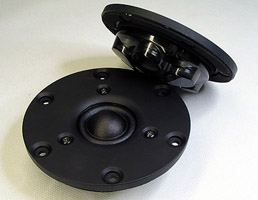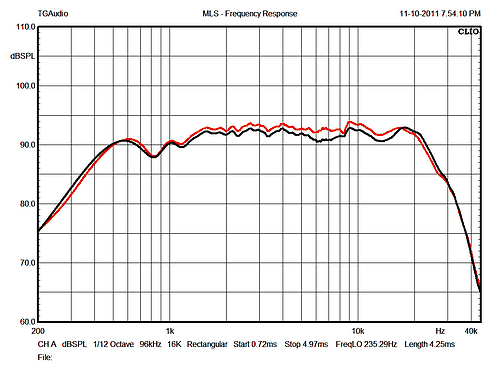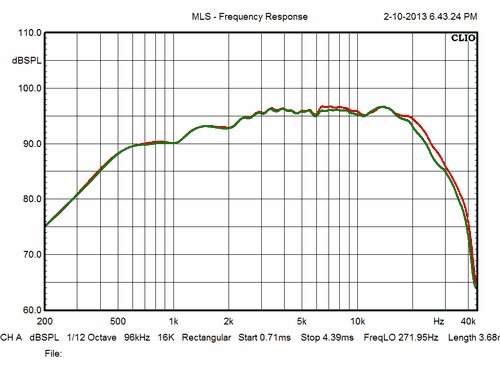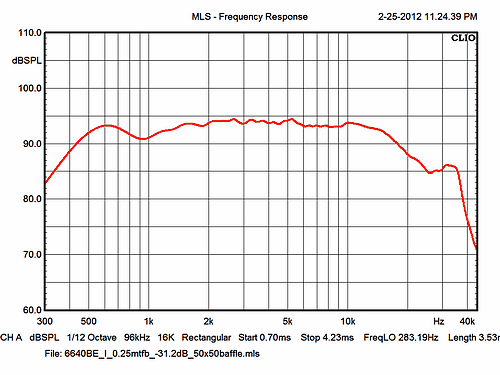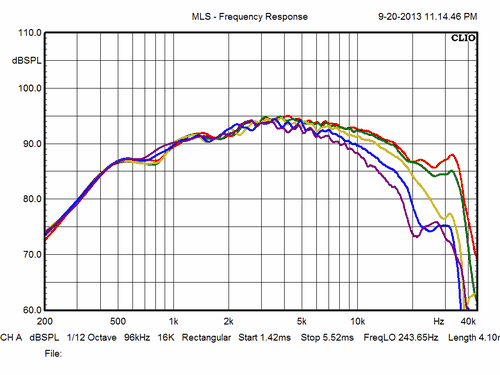|
ScanSpeak tweeters, D3004/660000, D2904/710003, D3004/664000 and R2908/714000 Copyright 2011-13 © Troels Gravesen Go to on this page: D3004/660000 D2904/710003 D3004/664000 D2908/714000
From left:
D3004/660000
D2904/710003
D3004/664000
D2908/714000 |
|
For future projects, a pair of 6600 and
7100 tweeters were acquired. The basic differences between these two
tweeters are the magnet system and the dome, where the 7100 has a ring
of damping glue to the dome. The ring neodym magnet of the 7100
tweeter provides a whopping 95+ dB sensitivity, suitable for fairly
high-efficiency systems where the 6600 does well up to 92 dB/2.8
volts. The 6600 display some inconsistency in sensitivity, around 1 dB
and although I don't regard this as a serious problem, a little
disappointing. Only two units were available for the 6600 tweeter. I
had another pair of 7100 for test, hence 4 samples on display below.
All of these are consistent in sensitivity and only display minor
differences between 15-20 kHz, probably due to the damping ring
applied. I wonder why SS added the damping ring as the 6600 display
less distortion in this area compared to 7100.
Both of these domes appear suitable for two-way systems with a very low point of crossover and from clients' project I know the 7100 can do well down to 1.5 kHz with a simple 2nd order crossover. The 7100 tweeter was tested in experimental designs and proved well down to 1.4 kHz, 12 dB/octave. Very impressive. The 6640 and 7140 Be domes were later added to my collection. All measurements done with tweeters flush-mounted on 35 x 50 cm baffle, center placement and 20 cm from top. An IEC baffle may provide better low-end response. The 6600 and 6640 tweeters present some challenges with regard to crossovers, because these tweeters go so low the can play midrange! The 7100 with its steeper low-end roll-off due to the very strong magnet system is easier. Taking the 6600 and 6640 down to 2 kHz and using a 12 dB/octave filter makes it necessary to apply impedance linearisation to render a smooth roll-off profile. |
|
D3004/66400
Beryllium dome
I don't think I've ever had a pair of so closely matched tweeters. They have outstanding performance in my Jenzen ATS speakers.
D2908/714000
Beryllium dome Measurements, baffle: 65 x 57 cm, 27 cm from top. All measurements normalised for 2.8V/1m. My expectations are high on this new tweeter and nothing below suggests I should be dissapointed. The Revelator magnet system is stronger compared to the Illuminator motor, thus an 8 ohms voice coil is used here. On top of this a titanium voice coil former, not seen before on ScanSpeak tweeters. Most noticeable is Qm, 7.3 according to specs. My measurements suggest a little lower, but nevertherless, nothing I've seen before. High Qm means low mechanical damping and some may fear this will make a too lively treble. Time will tell. I've heard reservations towards this 7140 tweeter based on the response graphs displayed at SS website. The use of a 10-100.000 Hz range doesn't make things look better on paper. Looking at the 1.000-20.000 Hz range alone (see below) display an usually well behaved response and initial modelling suggest an easy tweeter when it comes to crossovers. And let me say that I couldn't care less about the dip above 16 kHz towards 20 kHz. Some people are obsessed about a flat response to e.g. 30 kHz. There are much more to good treble performance than a ruler flat response to 30 kHz.
Now, all measurements above were done on a
large flat panal, but how does it look when it we use a small baffle
like the one I'm going to use for the next
ATS 4-way speaker? |
